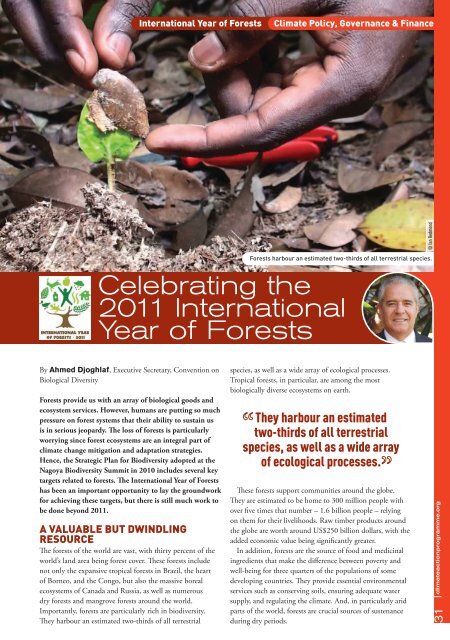Climate Action 2011-2012
You also want an ePaper? Increase the reach of your titles
YUMPU automatically turns print PDFs into web optimized ePapers that Google loves.
international Year of Forests<br />
climate Policy, governance & Finance<br />
© Ian Redmond<br />
Forests harbour an estimated two-thirds of all terrestrial species.<br />
Celebrating the<br />
<strong>2011</strong> International<br />
Year of Forests<br />
By Ahmed Djoghlaf, Executive Secretary, Convention on<br />
Biological Diversity<br />
Forests provide us with an array of biological goods and<br />
ecosystem services. However, humans are putting so much<br />
pressure on forest systems that their ability to sustain us<br />
is in serious jeopardy. The loss of forests is particularly<br />
worrying since forest ecosystems are an integral part of<br />
climate change mitigation and adaptation strategies.<br />
Hence, the Strategic Plan for Biodiversity adopted at the<br />
Nagoya Biodiversity Summit in 2010 includes several key<br />
targets related to forests. The International Year of Forests<br />
has been an important opportunity to lay the groundwork<br />
for achieving these targets, but there is still much work to<br />
be done beyond <strong>2011</strong>.<br />
A vAluAble but dwindling<br />
resource<br />
The forests of the world are vast, with thirty percent of the<br />
world’s land area being forest cover. These forests include<br />
not only the expansive tropical forests in Brazil, the heart<br />
of Borneo, and the Congo, but also the massive boreal<br />
ecosystems of Canada and Russia, as well as numerous<br />
dry forests and mangrove forests around the world.<br />
Importantly, forests are particularly rich in biodiversity.<br />
They harbour an estimated two-thirds of all terrestrial<br />
species, as well as a wide array of ecological processes.<br />
Tropical forests, in particular, are among the most<br />
biologically diverse ecosystems on earth.<br />
They harbour an estimated<br />
two-thirds of all terrestrial<br />
species, as well as a wide array<br />
of ecological processes.<br />
These forests support communities around the globe.<br />
They are estimated to be home to 300 million people with<br />
over five times that number – 1.6 billion people – relying<br />
on them for their livelihoods. Raw timber products around<br />
the globe are worth around US$250 billion dollars, with the<br />
added economic value being significantly greater.<br />
In addition, forests are the source of food and medicinal<br />
ingredients that make the difference between poverty and<br />
well-being for three quarters of the populations of some<br />
developing countries. They provide essential environmental<br />
services such as conserving soils, ensuring adequate water<br />
supply, and regulating the climate. And, in particularly arid<br />
parts of the world, forests are crucial sources of sustenance<br />
during dry periods.<br />
31 climateactionprogramme.org












